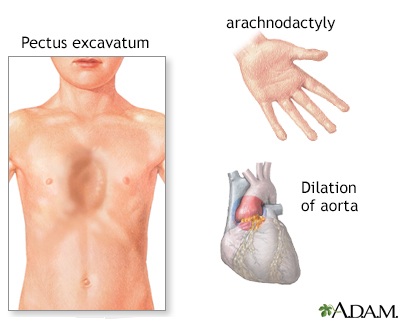Skeletal limb abnormalities
Skeletal limb abnormalities refers to a variety of bone structure problems in the arms or legs (limbs).
Considerations
The term skeletal limb abnormalities is most often used to describe defects in the legs or arms that are due to a problem with genes or chromosomes, or that occur due to an event that happens during pregnancy.
The abnormalities are often present at birth.
Limb abnormalities can develop after birth if a person has rickets or other diseases that affect bone structure.
Rickets
Rickets is a disorder that occurs in children before bone growth is complete. It is caused by a lack of vitamin D, calcium, or phosphate. It leads ...

Causes
Skeletal limb abnormalities may be due to any of the following:
- Cancer
Cancer
Cancer is the uncontrolled growth of abnormal cells in the body. Cancerous cells are also called malignant cells.
Read Article Now Book Mark Article - Genetic diseases and chromosomal abnormalities, including Marfan syndrome, Down syndrome, Apert syndrome, and Basal cell nevus syndrome
Marfan syndrome
Marfan syndrome is a disorder of connective tissue. This is the tissue that strengthens the body's structures. Disorders of connective tissue affect...
 ImageRead Article Now Book Mark Article
ImageRead Article Now Book Mark ArticleDown syndrome
Down syndrome is a genetic condition in which a person has 47 chromosomes instead of the usual 46.
Read Article Now Book Mark ArticleApert syndrome
Apert syndrome is a genetic disease in which the seams between the skull bones close earlier than normal. This affects the shape of the head and fac...
 ImageRead Article Now Book Mark Article
ImageRead Article Now Book Mark ArticleBasal cell nevus syndrome
Nevoid basal cell carcinoma syndrome is a group of conditions passed down through families. The disorder involves the skin, nervous system, eyes, en...
 ImageRead Article Now Book Mark Article
ImageRead Article Now Book Mark Article - Improper position in the womb
- Infections during pregnancy
- Injury during birth
- Malnutrition
Malnutrition
Malnutrition is the condition that occurs when your body does not get enough nutrients.
 ImageRead Article Now Book Mark Article
ImageRead Article Now Book Mark Article - Metabolism problems
Metabolism
Metabolism refers to all the physical and chemical processes in the body that convert or use energy, such as:BreathingCirculating bloodControlling bo...
 ImageRead Article Now Book Mark Article
ImageRead Article Now Book Mark Article - Pregnancy problems, including limb amputation from amniotic band disruption sequence
- Use of certain medicines during pregnancy including thalidomide, which causes the upper part of the arms or legs to be missing, and aminopterin, which leads to shortness of the forearm
When to Contact a Medical Professional
Contact your health care provider if you have any concerns about limb length or appearance.
What to Expect at Your Office Visit
An infant with limb abnormalities generally has other symptoms and signs that, when taken together, define a specific syndrome or condition or give a clue as to the cause of the abnormality. The diagnosis is based on a family history, your medical history, and a thorough physical evaluation.
Medical history questions may include:
- Does anyone in your family have skeletal abnormalities?
- Were there any problems during pregnancy?
- What illicit drugs or medicines were taken during the pregnancy?
- What other symptoms or abnormalities are present?
Other tests such as chromosome studies, enzyme assays, x-rays, and metabolic studies may be done.
Chromosome studies
Karyotyping is a test to examine chromosomes in a sample of cells. This test can help identify genetic problems as the cause of a disorder or diseas...

Enzyme
Enzymes are complex proteins that cause a specific chemical change. For example, they can help break down the foods we eat so the body can use them....
Read Article Now Book Mark ArticleReviewed By
Neil K. Kaneshiro, MD, MHA, Clinical Professor of Pediatrics, University of Washington School of Medicine, Seattle, WA. Also reviewed by David C. Dugdale, MD, Medical Director, Brenda Conaway, Editorial Director, and the A.D.A.M. Editorial team.
Herring JA. Skeletal dysplasias. In: Herring JA, ed. Tachdjian's Pediatric Orthopaedics. 6th ed. Philadelphia, PA: Elsevier; 2022:chap 36.
McClincy MP, Olgun ZD, Dede O. Orthopedics. In: Zitelli BJ, McIntire SC, Nowalk AJ, Garrison J, eds. Zitelli and Davis' Atlas of Pediatric Physical Diagnosis. 8th ed. Philadelphia, PA: Elsevier; 2023:chap 22.
McCandless SE, Kripps KA. Genetics, inborn errors of metabolism, and newborn screening. In: Fanaroff AA, Fanaroff JM, eds. Klaus and Fanaroff's Care of the High Risk Neonate. 7th ed. Philadelphia, PA: Elsevier; 2020:chap 6.

 All rights reserved.
All rights reserved.